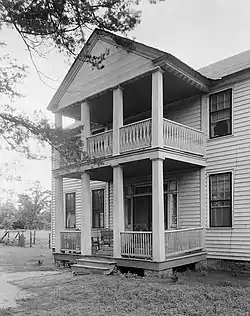Dry Fork Plantation
Dry Fork Plantation, also known as James Asbury Tait House, is a historic plantation house in Coy, Alabama. The two-story wood-frame house was built between 1832 and 1834 in a vernacular interpretation of Federal style architecture.[1] It was built for James Asbury Tait by two enslaved African Americans, Hezekiah and Elijah. The floor plan is centered on a hall that separates four rooms, two on each side, on both floors. Tait recorded in his daybook that the house required 25,000 board feet (59 m3) of lumber, the roof was covered with 6,000 wooden shingles, and the chimneys and foundation required 12,000 bricks, made from clay on the plantation. Dry Fork is one of the oldest houses still standing in Wilcox County and remains in the Tait family.[2] It was added to the National Register of Historic Places on February 26, 1999, with the name of Dry Forks Plantation.[1]
Dry Forks Plantation | |
 Front portico of Dry Fork in 1939 | |
  | |
| Nearest city | Coy, Alabama |
|---|---|
| Coordinates | 31°54′7″N 87°21′39″W |
| Built | 1834 |
| Architect | Hezekiah; Tait, James, et al. |
| Architectural style | Early Republic |
| NRHP reference No. | 99000250[1] |
| Added to NRHP | February 26, 1999 |
References
- "National Register Information System". National Register of Historic Places. National Park Service. April 15, 2008.
- "Dry Fork". Wilcox Area Chamber of Commerce. Archived from the original on September 19, 2008. Retrieved October 14, 2008.
External links
![]() Media related to Dry Fork Plantation at Wikimedia Commons
Media related to Dry Fork Plantation at Wikimedia Commons
- Historic American Buildings Survey (HABS) No. AL-137, "Dry Forks Plantation, County Road 12, Camden, Wilcox County, AL", 19 photos